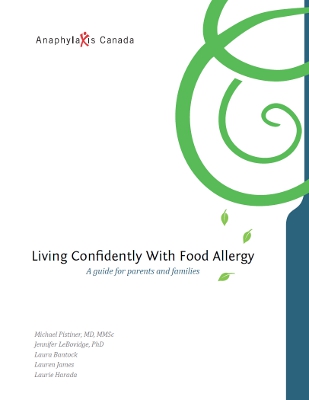1. “Sulphites – One of the nine most common food products causing severe adverse reactions.” Health Canada. 2009. Web. 8 August 2012. ‹http://www.hc-sc.gc.ca/›.
2. National Institute of Allergy and Infectious Disease (NIAID)-Sponsored Expert Panel. “Guidelines for the Diagnosis and Management of Food Allergy in the United States: Report of the NIAID-Sponsored Expert Panel.” The Journal of Allergy and Clinical Immunology 126.6 (2010): S1-S58.
3. Sampson, H.A. et. al. “Second symposium on the definition and management of anaphylaxis: Summary report—Second National Institute of Allergy and Infectious Disease/Food Allergy and Anaphylaxis Network symposium.” The Journal of Allergy and Clinical Immunology 117.2 (2006): 391-397.
4. Canadian Society of Allergy and Clinical Immunology. Anaphylaxis in School & Other Settings. 2nd Ed. Revised. 2011.
5. Maloney, J.M., Chapman, M.D., and Sicherer, S.H. “Peanut allergen exposure through saliva: Assessment and interventions to reduce exposure.” The Journal of Allergy and Clinical Immunology 118.3 (2006): 719-724.
6. Simonte, S.J. et al. “Relevance of casual contact with peanut butter in children with peanut allergy.” The Journal of Allergy and Clinical Immunology 112.1 (2003): 180-182.
7. Wainstein, B.K. et al. “Combining skin prick, immediate skin application and specific-IgE testing in the diagnosis of peanut allergy in children.” Pediatric Allergy and Immunology 18 (2007): 231–239.
8. Kim, J.S. and Sicherer, S.H. “Living with Food Allergy: Allergen Avoidance.” Pediatric Clinics of North America 58.2 (2011): 459-470.
9. Tulve, N. et al.“Frequency of mouthing behavior in young children.” Journal of Exposure Analysis and Environmental Epidemiology 12 (2002): 259–264.
10. Nicas, M., and Best, D.J. “A study quantifying the hand-to-face contact rate and its potential application to predicting respiratory tract infection.” Journal of Occupational Environmental Hygiene 5.6 (2008): 347-52.
11. Roberts, G., Golder, N. and Lack, G. “Bronchial challenges with aerosolized food in asthmatic, food-allergic children.” Allergy 57.8 (2002): 713-7.
12. Hefle, S.L. et al. “Consumer attitudes and risks associated with packaged foods having advisory labeling regarding the presence of peanuts.” The Journal of Allergy and Clinical Immunology 120.1 (2007): 171-176.
13. Perry, T.T. et al. “Distribution of peanut allergen in the environment.” Journal of Allergy and Clinical Immunology 113.5 (2004): 973-6.
14. Sampson, H.A., Mendelson, L. and Rosen, J.P. “Fatal and near-fatal anaphylactic reactions to food in children and adolescents.” New England Journal of Medicine 327 (1992): 380-384.
15. Rudders, S.A. et al. “Multicenter study of repeat epinephrine treatments for food-related anaphylaxis.” Pediatrics 125.4 (2010): e711-e718.
16. Bock, A.S., Muñoz-Furlong, A. and Sampson, H.A. “Fatalities due to anaphylactic reactions to foods.” The Journal of Allergy and Clinical Immunology 107.1 (2001): 191-193.
17. Pumphrey, R.S.H. “Fatal posture in anaphylactic shock.” The Journal of Allergy and Clinical Immunology 112.2 (2003): 451-452.
18. Simon, E. et al. “World Allergy Organization guidelines for the assessment and management of anaphylaxis.” World Health Organization – World Allergy Organization Journal (2011) 21-22.
19. Ellis, A.K. and Day, J.H. “Incidence and characteristics of biphasic anaphylaxis: a prospective evaluation of 103 patients.” Annals of Allergy, Asthma & Immunology 98.1 (2007): 64-69.
20. Muñoz-Furlong, A. “Daily Coping Strategies for Patients and Their Families.” Pediatrics 11.3 (2003): 164-1664.
21. Young, M.C., Munoz-Furlong, A. and Sicherer, S.H. “Management of food allergies in schools: a perspective for allergists.” Journal of Allergy and Clinical Immunology 124.2 (2009): 175–182.
22. McIntyre, C.L., Sheetz, A.H., Carroll, C.R. and Young, M.C. “Administration of epinephrine for life-threatening allergic reactions in school settings.” Pediatrics 116.5 (2005): 1134-1140.
23. Sicherer, S., Furlong, T.J., DeSimone, J., and Sampson, H.A. “The US Peanut and Tree Nut Allergy Registry: Characteristics of reactions in schools and daycare.” Pediatrics 38 (2001): 560-565.
24. Furlong, T.J., DeSimone, J. and Sicherer, S.H. “Peanut and tree nut allergic reactions in restaurants and other food establishments.” The Journal of Allergy and Clinical Immunology 108.5 (2001): 867-870.
25. Cohen, B.L., Noone, S., Munoz-Furlong, A. and Sicherer, S.H. “Development of a questionnaire to measure quality of life in families with a child with food allergy.” Journal of Allergy and Clinical Immunology 114 (2004): 1159-63.
26. Mandell, D., Curtis, R., Gold, M., and Hardie, S. “Families coping with a diagnosis of anaphylaxis in a child. A qualitative study of informational and support needs.” Allergy & Clinical Immunology International – Journal of the World Allergy Organization 14 (2002): 96-101.
27. DunnGalvin, A., Gaffney, A. and Hourihane, J.O’B. “Developmental Pathways in food allergy: a new theoretical framework.” Allergy – European Journal of Allergy and Clinical Immunology 64.4 (2009): 560-568.
28. Sampson, M.A., Munoz-Furlong, A. and Sicherer, S.H. “Risk-taking and coping strategies of adolescents and young adults with food allergy.” Journal of Allergy and Clinical Immunology 117.6 (2006): 1440-5.
29. Monks, H. et al. “How do teenagers manage their food allergies?” Clinical and Experimental Allergy 40.10 (2010): 1533-1540.
30. Chapman, J.A. et al. “Food allergy: a practice parameter.” Annals of Allergy, Asthma & Immunology 96.3 (2006): S1-S68.
